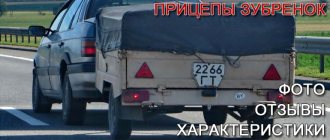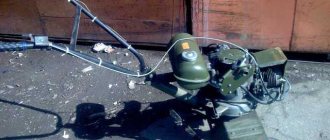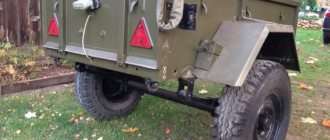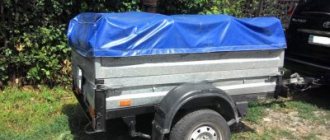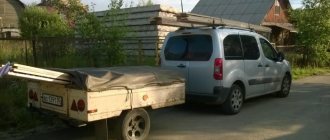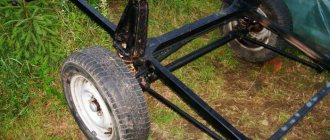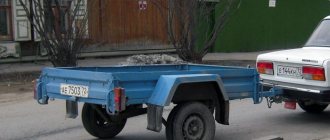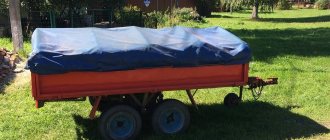The Bee trailer is a proven way to transport goods
The Bee trailer is a primitive unit that has never required special treatment. But driving around Russia, for 20 years he left a clear path and, in the hands of responsible and skillful car owners, more than once returned to a new life.
The owners admit that they did not regret at all, condemning the towed device with the children's name “Bee” to the most difficult operating conditions:
- Excessive weight overload.
- Exceeding the speed limit.
- Extreme towing over rough terrain.
- Severe storage and preservation conditions.
Since the unit, due to the simplicity of its design, could not even be a donor for other equipment, its fate, after another lost battle with the road, was repeated again and again - restoration.
How to convert wheels to a trailer
Trailer wheels can fail due to regular overloads, old tubes, excess pressure in the tubes, which happens when the wheels are “over-inflated”.
For example, how can a bee trailer be converted to Zhiguli wheels if its inner tube has burst for the fourth time in four years of operation? Drivers no longer try to look for and mount 10-inch wheels, since they cannot withstand the loads. And many people do not consider buying consumables native to the bee as the optimal solution to the problem.
Technical characteristics of the Nefaz 8122 model
With a chance to see a new, unexploited model, you can immediately understand that Napoleonic plans are fading into oblivion.
- Low load capacity.
- Poor performance of the material.
- Zero visibility in side mirrors.
Or maybe that’s why motorists load it beyond the norm. They want to feel with their bodies that there is a Bee trailer behind them. They probably didn't read these modest numbers:
- One axis.
- Dump body.
- Straight drawbar.
- Load capacity 200 kg.
- Curb weight 125 kg.
- Total weight 325 kg.
- The permissible load on the coupling unit with the car is 30 kg.
- Body dimensions 1.2x1.6 m.
- Folding rear and front sides increase the length to 2.4 m.
- Useful area 1.8 m2.
- The volume of the standard configuration is 0.61 m3.
- Volume with frame 1.44 m3.
- The independent suspension consists of: Cross arms.
- Friction shock absorbers.
- Springs.
The package includes four options:
- No awning.
- With a low awning.
- With an extension frame and a high awning.
- With frame and both awnings.
Trailer Nefaz Pchelka: characteristics, operating features
The Bee trailer is a primitive unit that has never required special treatment. But driving around Russia, for 20 years he left a clear path and, in the hands of responsible and skillful car owners, more than once returned to a new life.
The owners admit that they did not regret at all, condemning the towed device with the children's name “Bee” to the most difficult operating conditions:
- Excessive weight overload.
- Exceeding the speed limit.
- Extreme towing over rough terrain.
- Severe storage and preservation conditions.
Since the unit, due to the simplicity of its design, could not even be a donor for other equipment, its fate, after another lost battle with the road, was repeated again and again - restoration.
Technical characteristics of the Nefaz 8122 model
With a chance to see a new, unexploited model, you can immediately understand that Napoleonic plans are fading into oblivion.
- Convenience.
- Ease.
- Compactness.
Combined:
- Low load capacity.
- Poor performance of the material.
- Zero visibility in side mirrors.
Or maybe that’s why motorists load it beyond the norm. They want to feel with their bodies that there is a Bee trailer behind them. They probably didn't read these modest numbers:
- One axis.
- Dump body.
- Straight drawbar.
- Load capacity 200 kg.
- Curb weight 125 kg.
- Total weight 325 kg.
- The permissible load on the coupling unit with the car is 30 kg.
- Body dimensions 1.2x1.6 m.
- Folding rear and front sides increase the length to 2.4 m.
- Useful area 1.8 m2.
- The volume of the standard configuration is 0.61 m3.
- Volume with frame 1.44 m3.
- The independent suspension consists of: Cross arms.
- Friction shock absorbers.
- Springs.
The package includes four options:
- No awning.
- With a low awning.
- With an extension frame and a high awning.
- With frame and both awnings.
Tuning the Nefaz 8122 model
A common model of the Bee trailer is Nefaz 8122. On the farm it is used as a trailed cart, as opposed to a hand cart. Its characteristics do not forgive overload in weight, so the bee is very convenient seasonally, so to speak, for small things. But going on the highway with an empty body is dangerous, since the unit jumps all the time and the suspension behaves unpredictably.
Tuning the Nefaz 8122 model
A common model of the Bee trailer is Nefaz 8122. On the farm it is used as a trailed cart, as opposed to a hand cart. Its characteristics do not forgive overload in weight, so the bee is very convenient seasonally, so to speak, for small things. But going on the highway with an empty body is dangerous, since the unit jumps all the time and the suspension behaves unpredictably.
To understand how to operate a trailer, an example of its connection to a walk-behind tractor equipped with a towbar is given. Trailers, regardless of their price class, are specialized devices in accordance with acceptable operating conditions. After all, few people can carry an armful of logs on a frame boat trailer, because for this there is a trailer with a manipulator. Transportation of medium-sized cargo, bulk building materials, agricultural products weighing no more than 200 kg - this is its direct purpose. But they forget about it. And after another failure, they spend time on repairs and re-equipment:
- The suspension undergoes a major upgrade. In most cases, instead of springs, springs are installed with at least three leaves per wheel. The donor is Moskvich 412. The shock absorbers are also suitable for this.
- The trailer behaves more confidently on the road after replacing the suspension, but the driver is not satisfied with the optical devices: the light is dim, or the shape is not right. The second optic is being replaced.
- Apparently, after changing the optics to bright ones, the driver notices weak wheels. Replacing it with a 13th or 14th radius solves the problem. However, the hub units are also not satisfactory. You can’t do it without a welder, and VAZ hubs fit just right.
Work order
- We make holes for fastening in the VAZ hubs. The most important thing is to drill exactly vertically.
- We dismantle old wheels.
- After this, we install the adapter, first the first part of the collapsible structure.
- We put the hub on this part.
- Now we install the second part from the adapter, with which the unused bearing will be clamped.
- We install the original nut and secure it with a cotter pin.
- We install the wheel.
- We repeat the procedure with the remaining wheels.
As you can see, if you want to cope with such a task as altering the wheels on a trailer, it is quite possible.
For beginners, just in case, we will add information about wheels so that no one accidentally buys completely unnecessary products or equipment that will not be useful to you.
Novice drivers mistakenly believe that the letter R on the wheels is their radius. Nothing like this! R means that these tires are radial (a method of assembling metal cord and rubber). And if you see the letter D on the rubber, this is again not a diameter, but a bias tire (another method of arranging cord and rubber).
The numbers after the letter R indicate the diameter of the hole in the tire; this indicator must correspond to the outer diameter of the rim. And keep in mind that these dimensions are always indicated in inches (1 inch equals 25.4 millimeters). That is, the R 16 is a radial tire on a wheel with a diameter of 16 inches or 406.4 mm.
Features of operating the Bee trailer
The Bee trailer has a number of weak points that appear when used incorrectly:
- Single row wheel bearings are very noisy.
- The hub assembly rusts and becomes inseparable.
- If you are forced to drive on a flat tire, thin rims will become unusable.
- Wheels fail due to:
- Overload.
- The efforts of the camera.
- Tire speed index.
- Pumping.
- Heating
- An empty unit bounces as the air dampers stop resisting the rough road.
- The coupling mechanism has play.
Video review of tuning the Bee trailer
In conclusion, do not throw up your hands. The bee trailer is a reanimated unit that promotes the development of ingenuity and creativity of the owner. An ideal option not only for gardening conditions, but also for unlimited tuning.
Source
Trailer Bee - replacing R10 wheels with R13
The first time this happened was when I was transporting a trailer of sand - a tire went flat, and by the time I noticed and stopped, the cups became unusable.
The tire was chewed, the rim was bent, and it was completely beyond repair. It’s okay, I thought, I have 4 more of them. A spare wheel and 3 long-term but unused wheels from a walk-behind tractor (to fit, you need to cut out the inner diameter and drill holes). The last wheel ended after a year and a half. The reasons were overloads, old tubes, tire speed index, pumping, heating, a lot of things...
The camera burst again, there were 6 km left to the destination on a dirt road, I didn’t want to throw away the cargo. By that time, I no longer tried to find 10-inch wheels; I considered it inadvisable to constantly spend money on original/compatible consumables (disposable ones, if with a load, they are killed). I decided to go like this. The tires are quite hard, I would have gotten there empty, it was an experience (if you get a flat, unload to the side of the road, you drive on). A good reason to finally replace it with standard wheels. I’m almost there, the last 100 meters are on the hub. The wheel is trash.
It's a pity for the hub (the mounting holes correspond to the VAZ ones):
I had to urgently solve the problem. I bought hubs at a car disassembly shop - the front ones for the classics were out of stock, they were only assembled with drums, I agreed only on the hubs, I had to remove the drums myself with a hammer. While working together, I agreed on 3 wheels of 13 radius (initially I wanted 14, so as not to carry an extra spare wheel, but then the rear comes out higher than the drawbar and the balance of weight distribution with bulk materials is upset.
After reading the forums and preparing the materials, I began work over the weekend.
The frame was modified earlier, it’s a pity I didn’t immediately think of strengthening it with gussets.
I roughly figured out how the wheel would fit
To position the wheels correctly (not on the reverse side, it was necessary to make small spacers, the material I chose was a 40x4mm strip.
Installed correctly to see the result
And a short photo session:
Paying attention to the unaesthetic quality of the weld, I reinforced the seams with a second layer.
The result fully met my expectations, of course there was no perfect alignment, but there were no problems in movement (at the start of using the modified solution I closely monitored it, then I got used to it being the same).
Undecided:
There was still a problem with the suspension - when the trailer is overloaded, when one wheel hits a bump, the trailer starts to wobble, the first time I encountered this was on R10 wheels, there was a lot of fear, I was smart enough not to brake, but even to accelerate a little... so far there have been 2 such cases, the second time was on R13, I already knew what to do. After such cases, be sure to check the tightness of the bolts. The problem with cargo shifting to the front side of the trailer has increased, because... the trailer has become higher, but the drawbar still clings to the hook on the Lada Kalina. You need to take this into account when balancing the load (mainly a problem with bulk materials. I couldn’t figure out where to store the spare tire, now I drive it in the trunk of a car, I would like to find a mounting location so that I could balance the weight distribution with its help. Initially I intended to place it under the bottom near the rear wall I couldn’t figure out how to solve the problem of fastenings and leave the possibility of unloading cargo by tipping

